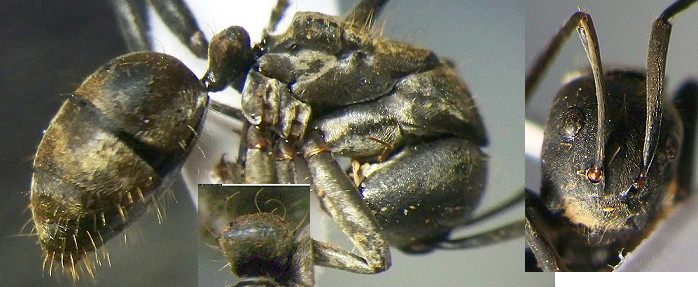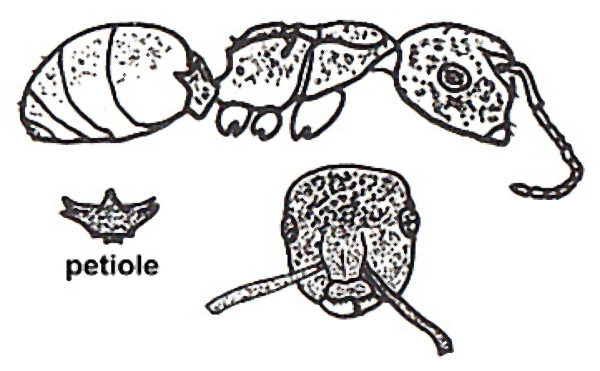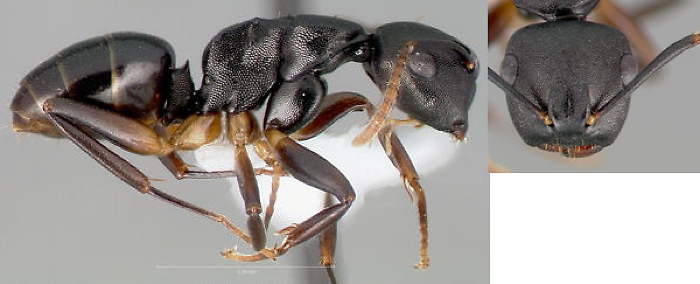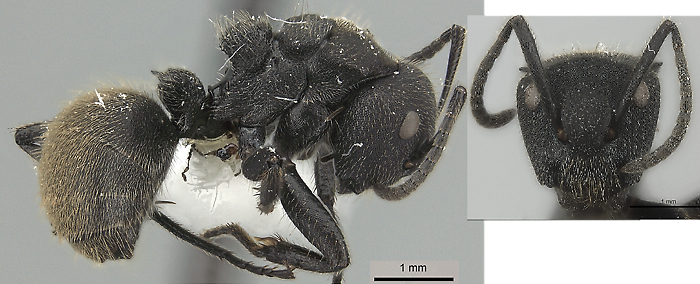SUBFAMILY FORMICINAE - Genus Phasmomyrmex
| The Ants of
Africa SUBFAMILY FORMICINAE - Genus Phasmomyrmex |
|
| Contents - Formicinae - FORMICINAE Introduction |
In Tribe CAMPONOTINI.
Diagnostic Features - Monomorphic. Insertions of antennae,
form of frontal carinae and eyes as in Camponotus. Clypeus with
median portion broadly and shallowly excised. Pronotum with
anterodorsal angles projecting as short teeth, or the sides strongly
marginate. Metanotal groove impressed, the propodeum truncated
posteriorly and usually unarmed. Petiole nodiform and extended into at
least a short dorsolateral tooth on each side. Acidopore circular, not
concealed. Stitz's (1910) genus definition (as a Dolichoderine) is at ![]() .
.
The subgeneric names, Myrmacantha and Myrmocrhachis are as in Bolton (1995), although such subdivision seems unnecessary in a genus with only four known species. Myrmacantha was described by Emery (1920b: 246) as a new subgenus of Camponotus, with the head obtusely truncate anteriorly; alitrunk wide and shouldered, or with the pronotum rounded (type species Camponotus aberrans) where the petiole scale has lateral extensions; propodeum unique (for Camponotus). Emery (1925b: 58) changed the status to a subgenus of Phasmomyrmex. Emery (1920b: 252) had supported the Stitz definition of Phasmomyrmex for the single species buchneri. Myrmorhachis (type species Camponotus polyrhachoides Forel, 1912i: 92, replacement name for Polyrhachis paradoxa André, 1892a: 46; provisional junior synonym of Phasmomyrmex, Brown, 1973b: 182 - e.g. listed as "Myrmacantha Emery 1920 = Phasmomyrmex?").
Wheeler (1922: 701) revived the genus status - alitrunk and petiole without spines or teeth; no marked dimorphism; funiculus filiform; body slender, head rectangular with rounded posterior angles; clypeus flat, without carina or lobe, broadly notched in middle of anterior margin; alitrunk dorsum flat, obtusely margined, with three sutures; pronotum with projecting humeral angles; propodeum truncate posteriorly; petiole scale very thick, angulate on the sides of its dorsal face.
Four species - all arboreal, nesting and foraging in trees.
Key to species
| 1 |  Petiole with rounded
apex in lateral view and simple
lateral processes; entire body with yellowish pubescence; entirely matt
black, with reddish extremities; TL 12 mm Petiole with rounded
apex in lateral view and simple
lateral processes; entire body with yellowish pubescence; entirely matt
black, with reddish extremities; TL 12 mm |
. |
| . |  |
Congo Basin - buchneri |
| -- |  Petiole with lateral
processes bifurcate; gaster without
significant pubescence; black with orange extremities, shiny; TL
5.9-7.5 mm (queen TL 7.5-8.5 mm) Petiole with lateral
processes bifurcate; gaster without
significant pubescence; black with orange extremities, shiny; TL
5.9-7.5 mm (queen TL 7.5-8.5 mm) |
. |
| . |  |
West Africa & Congo Basin - aberrans |
| -- |  Queen only described (shown on species page); petiole
scale thick and double
ended but without a median spine, otherwise similar to the queen of aberrans
but more subtly sculptured, with the gaster unsculptured; TL 7.5 mm,
wing 7 mm. Queen only described (shown on species page); petiole
scale thick and double
ended but without a median spine, otherwise similar to the queen of aberrans
but more subtly sculptured, with the gaster unsculptured; TL 7.5 mm,
wing 7 mm.Likely worker shown here is from from Antweb images |
Cameroun - wolfi |
| -- |  Petiole with narrow
scale, convex in front and rear,
laterally armed with two short divergent spines; only gaster with quite
dense yellow-gold pubescence, masking underlying dark colour; TL 7 mm Petiole with narrow
scale, convex in front and rear,
laterally armed with two short divergent spines; only gaster with quite
dense yellow-gold pubescence, masking underlying dark colour; TL 7 mm |
. |
| . |  |
West Africa & Congo Basin - paradoxus |
| Subfamily Formicinae |
© 2007, 2009, 2010, 2013 - Brian Taylor CBiol FSB FRES 11, Grazingfield, Wilford, Nottingham, NG11 7FN, U.K. |
href="phasmomyrmex.htm"